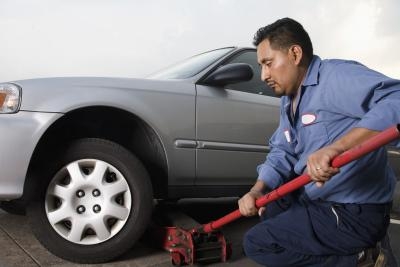
The Hyundai Elantra uses a MacPherson strut front suspension, which is common to front-wheel drive cars. The MacPherson strut incorporates the spring and shock absorber into a single unit which mounts on the lower control arm at the bottom, and the body at the top, eliminating the need for an upper control arm. In order to replace the strut, the entire strut and spring assembly must be removed and extreme caution must be used when working around the compressed spring.
Park your Elantra on a level, paved surface and set the parking brake. Loosen the lug nuts on the front wheels. Raise the front of the Elantra with a jack and support with jack stands. Finish removing the lug nuts and wheels.
Use a ratchet and socket to remove the bolt from the brake hose bracket and ABS wiring bracket -- if equipped -- where they attach to the strut.
Use the ratchet and socket to remove the two nuts from the bolts at the bottom of the strut that attach it to the steering knuckle. Use a hammer and punch to tap out the bolts.
Have an assistant hold the bottom of the strut while you move to the engine compartment and remove the three nuts that hold the strut onto the strut tower, on the body. You may have to tap the bottom of the strut off the steering knuckle. Lower the strut out through the fender well. Run a piece of wire through one of the bolt holes in the steering knuckle and tie it to the lower control arm, so the knuckle does not fall outwards.
Mount a spring compressor near the top and bottom of the spring. The spring compressor consists of two threaded rods with hooked fittings at each end that fit over spring coil. One rod goes on each side of the spring. Tighten the nuts on the rods to evenly compress the spring.
Use a screwdriver to pry off the dust cover on top of the strut. Use a ratchet and socket to remove the nut from the shaft in the center of the strut. Lift off the top mounting plate, spring seat and rubber insulator. If the rubber insulator is cracked, replace it. Note how the spring sets in the bottom of the strut. The mount in the bottom of the strut actually curves down. The end of the spring sits in the bottom of the curve. Carefully lift the spring off the strut and set it aside. Do not drop or throw the spring, because there's a lot of energy stored in it and you can be injured if it slips off of the compressors.
Remove the rubber spring seat from the bottom of the strut and place it on the new strut. If the rubber seat is cracked or excessively worn, replace it. Make sure it is properly positioned with the downward curve for the spring. Carefully lower the spring into position on the strut with the end of the spring seated in the bottom of the curve.
Mount the upper insulator, spring seat and top mounting plate. Install and tighten the nut on the center strut shaft to 45 foot-pounds with a torque wrench and socket. Slide the strut a assembly into the fender well and guide the three mounting studs at the top of the strut into the strut tower. Install the three nuts on the studs finger tight.
Remove the wire from the steering knuckle and have your assistant hold the knuckle in place while you slide the bottom of the strut onto the knuckle. Line up the holes and install the bolts. Install the nuts and tighten them to 90 foot-pounds. Tighten the three nuts on top to 30 foot-pounds. Mount the brake line bracket and ABS bracket to the strut and tighten the bolts.
Install the wheels and lug nuts. Raise the front of the Elantra, remove the jack stands, lower the Elantra to the ground and finish tightening the lug nuts.